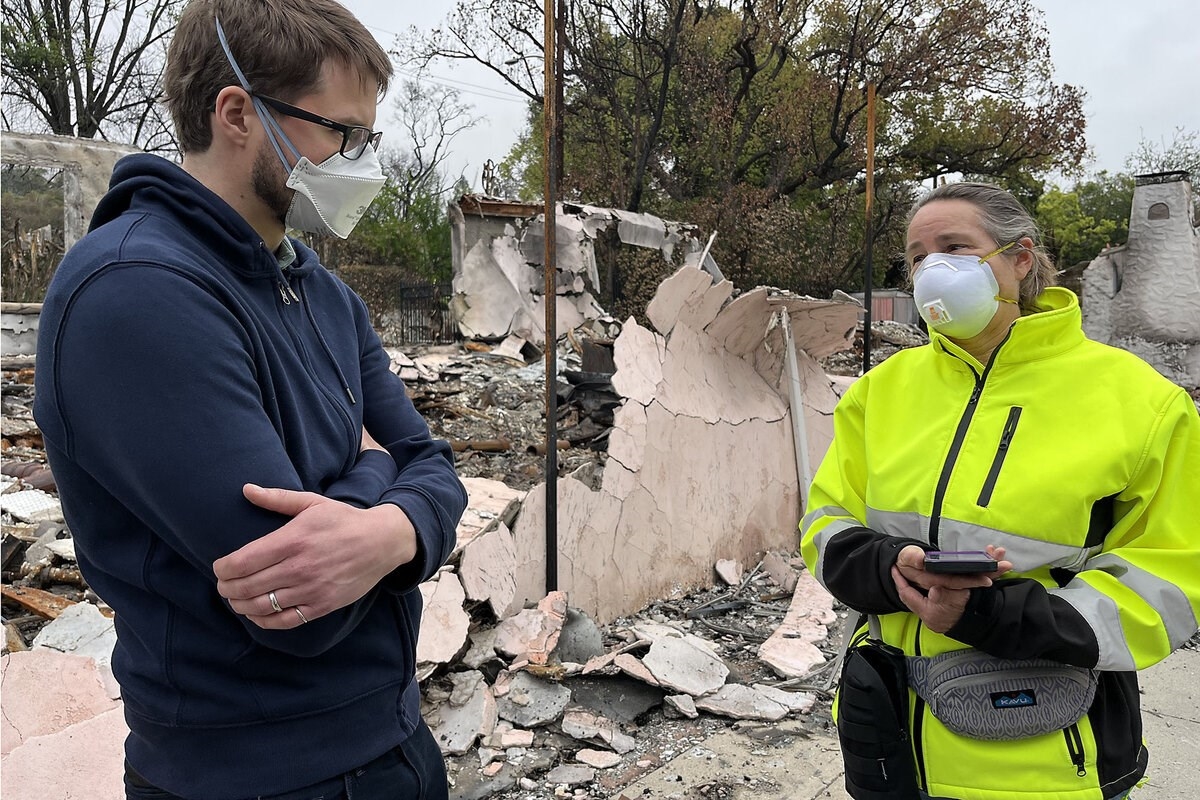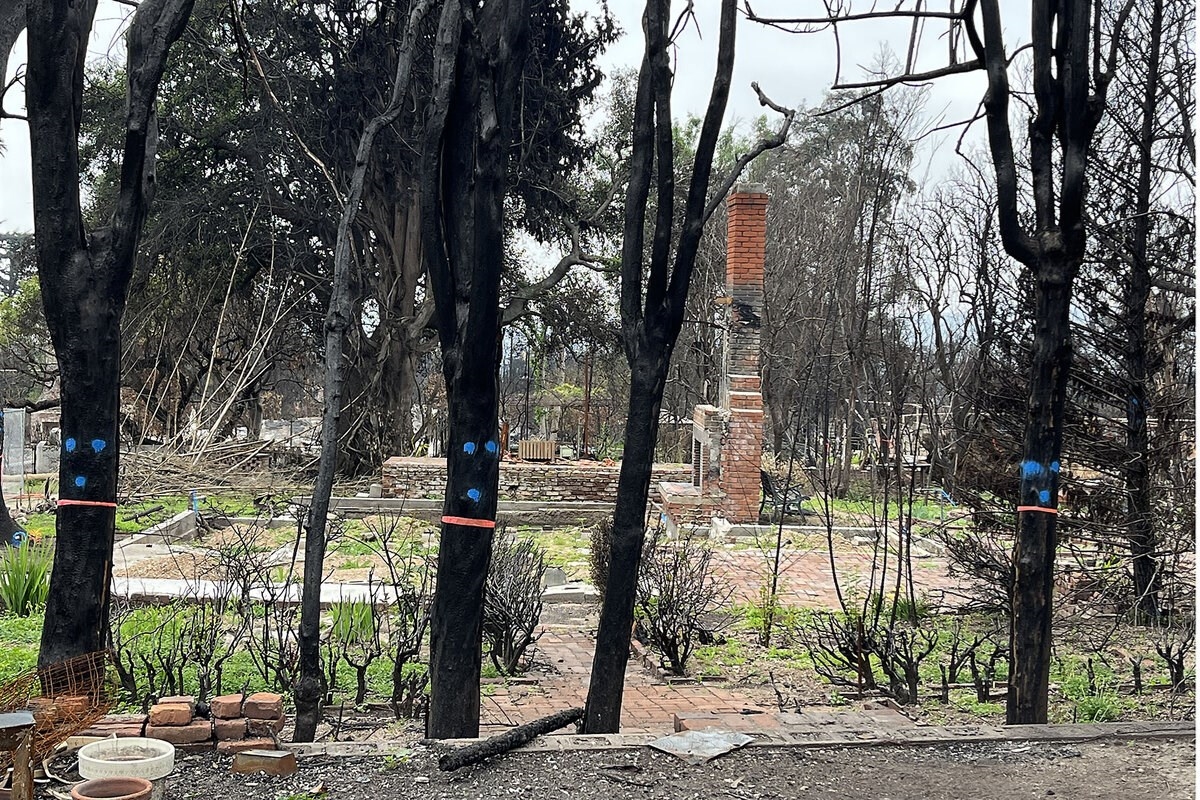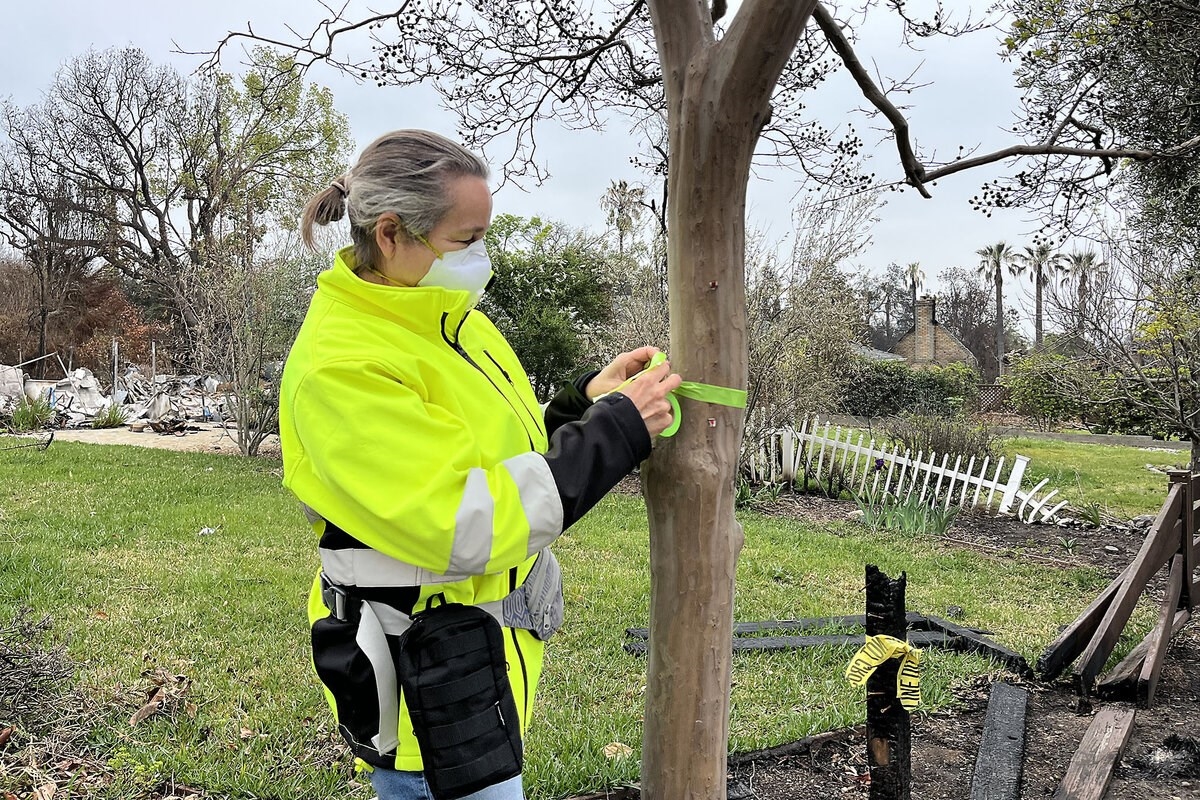REPRINTED WITH PERMISSION FROM THE CHRISTIAN SCIENCE MONITOR
After the recent California fires, the Army Corps of Engineers caused an uproar with the early mismarking of trees as hazardous. Residents and professional arborists responded, the Corps listened, and collaboration is now leading to new growth.
 Arborist Rebecca Latta (right) and a client walk the driveway of a home destroyed in Southern California’s wildfires in January. Neither this man’s house nor his jacaranda tree at the back survived the Eaton Fire, but the outlook for the trees in front is good, in Altadena, California, March 26, 2025. Francine Kiefer/The Christian Science Monitor
Arborist Rebecca Latta (right) and a client walk the driveway of a home destroyed in Southern California’s wildfires in January. Neither this man’s house nor his jacaranda tree at the back survived the Eaton Fire, but the outlook for the trees in front is good, in Altadena, California, March 26, 2025. Francine Kiefer/The Christian Science Monitor
|Altadena, Calif.
It was his late wife’s favorite tree – a stunning jacaranda, tall and full, that produced a mass of violet-colored blossoms every spring. In Southern California, the joyful “jacs” are the equivalent of cherry trees in other climes.
On a recent afternoon, however, Altadena homeowner Jamie is learning that the beloved tree did not survive the deadly Eaton Fire, one of two highly destructive wildfires that roared through Los Angeles County this past January. It consumed his Spanish-style home and more than 16,000 other houses and buildings here and in the coastal community of Pacific Palisades. At least 30 people were killed and thousands were displaced.
Trees were subject to temperatures as high as 2,000 degrees Fahrenheit, and this favorite tree was just too close to the burning structure. It was severely scorched, and now its blackened limbs reach into a gray sky in his backyard, a once-cozy retreat now surrounded by rubble.
“It’s not coming back,” arborist Rebecca Latta informs Jamie, who for privacy asked that his last name not be used.
 Francine Kiefer/The Christian Science MonitorArborist Rebecca Latta talks with a client in the driveway of his Altadena, California, home, burned by the Eaton Fire just three months before, March 26, 2025.
Francine Kiefer/The Christian Science MonitorArborist Rebecca Latta talks with a client in the driveway of his Altadena, California, home, burned by the Eaton Fire just three months before, March 26, 2025.
But Jamie’s front yard is a different story and offers a glimmer of hope for this traumatized California community, where residents have long viewed trees as a defining and comforting presence. Green grass covers the expanse that stretches to the street. Several olive trees toward the front of the property are in decent shape, and the crepe myrtle is only slightly burnt. “This is a fixable problem,” says the arborist, masked up and wearing boots to protect from the fire debris.
Looking down his street, Jamie marvels that many of the large trees edging the road appear untouched, though the houses are gone. He likens living in Altadena before the Eaton Fire to living in a forest. “It’s very quiet, and the trees have a lot to do with that,” he says. “I really hope now Altadena stays kind of forest-y like it has been, and people don’t start basically getting rid of trees unnecessarily.”
Trees incorrectly tagged as hazardous and rampant bulldozing of trees caused an uproar among Altadenans in the beginning stages of debris clearing. People in this historic community near Los Angeles are passionate about their lush canopy, which Ms. Latta describes as “unique” for this semiarid area. She and other landscape professionals have mobilized to protect as much of it as possible, forming Altadena Green – a real-life Lorax that speaks for the trees and is a resource for residents.
Eventually, the outcry was heard by the U.S. Army Corps of Engineers, responsible for identifying and removing hazardous trees and structural debris on properties where homeowners have granted them the right of entry. In response, the Corps has made significant changes.
“They finally listened, and they began to collaborate, and over the past couple months, we’ve been able to save so many trees,” says Wynne Wilson, a landscape designer and spokesperson for Altadena Green, who lost her home in the fire. She was shocked to see healthy trees on her property misidentified as dead simply because they did not have leaves.
“They weren’t even hit by fire. There was not even any scorching. It was just because they were deciduous,” she exclaims. “The lack of knowledge was huge. So we scrambled.”
 Francine Kiefer/The Christian Science MonitorTrees in Altadena, California, show the U.S. Army Corps of Engineers' marking system of three blue dots to identify hazardous or dead trees for removal, March 26, 2025.
Francine Kiefer/The Christian Science MonitorTrees in Altadena, California, show the U.S. Army Corps of Engineers' marking system of three blue dots to identify hazardous or dead trees for removal, March 26, 2025.The Army Corps uses arborists certified by the International Society of Arboriculture. But they were from out of the area and unfamiliar with local tree species, explains Ms. Wilson. Her group worked as a conduit between upset residents and the Corps, and as a result, Corps teams partnered with local arborists, reviewed marked trees, and corrected those wrongly identified. It also offered residents waivers from tree removal that allow a tree to stay in place, with the homeowners assuming the risk of any problems.
Some owners want more time to see if their damaged tree will survive. “The challenge that the Corps has is that we’re here for a finite amount of time,” says Army Corps Col. Eric Swenson, who is overseeing debris removal for the LA fires. “We don’t have time on our side. We have to get the mission done.” The waivers solve that problem, he says. “We’ve listened to the community.”
Drive through the area, though, and it’s understandable how barcodes and various colored markings and ribbons applied to trees confuse residents – despite press conferences and explanations on the Corps website.
People have been known to move to Altadena just for the trees. They appreciate the beauty, wildlife, shade, and cooling when summer temperatures can top 100 F. Many of the trees go back more than a century, planted by people who moved to this area at the base of the scrubby San Gabriel Mountains. Twisty olive trees from past groves grew along with towering sycamores, eucalypti, and deodar cedars. Coastal live oaks stretched their long branches into a graceful embrace.
 Francine Kiefer/The Christian Science MonitorArborist Rebecca Latta ties a green ribbon for "keep" around a slightly scorched crepe myrtle tree outside a house destroyed by the January Eaton Fire in Altadena, California, March 26, 2025.
Francine Kiefer/The Christian Science MonitorArborist Rebecca Latta ties a green ribbon for "keep" around a slightly scorched crepe myrtle tree outside a house destroyed by the January Eaton Fire in Altadena, California, March 26, 2025.
The canopy, composed of more than 200 tree species, differed from that in Pacific Palisades. Altadena’s covering was bigger and denser, says Ms. Latta, a former forester for the neighboring city of Pasadena.
“If you really want a good example of what happened, look at pictures of Altadena from satellite, from space,” she says. “You can see it’s just solid green.”
Not anymore. Ms. Latta guesstimates that about 50% of the Altadena canopy has been lost, 40% is intact, and 10% could recover if people don’t take trees down, even if they are damaged. The loss will have a “huge” impact, she says. “It’s going to be hotter in the summer, and it’s going to be harder to get away and shelter from the high summer peak when it gets to be 118 and 120 here.”
Despite her reputation as a “tree whisperer,” Ms. Latta says it’s tricky assessing damaged trees. Sometimes, a tree that looks like it’s going to make it will not. It might be sending out a springtime bloom, but it could be a last gasp as the tree uses up its remaining moisture. At the same time, a scorched tree that looks dead could survive.
She points to new growth on a blackened coastal live oak, saved by its thick bark. Those trees can be helpful in a fire because their cupped leaves catch embers. Trees that hold a lot of moisture can also protect structures.
Altadena Green is eyeing a future of replanting and teaching about ecology. It wants to start the “acorn project,” in which local acorns are propagated in greenhouses. In three to five years, the saplings would debut in community planting events. And it wants to plant appropriate, faster-growing trees, given that it will take at least 25 to 50 years to restore the canopy, according to Ms. Wilson. The group is starting a fundraising PayPal portal at SaveOurPlanet.org.
As Ms. Latta finishes her rounds through charred neighborhoods, she offers this parting advice for homeowners trying to save their trees: Water consistently the whole root zone, mulch to protect the soil from heat, and then water again.
Page created on 4/13/2025 12:32:01 PM
Last edited 4/13/2025 12:46:26 PM
